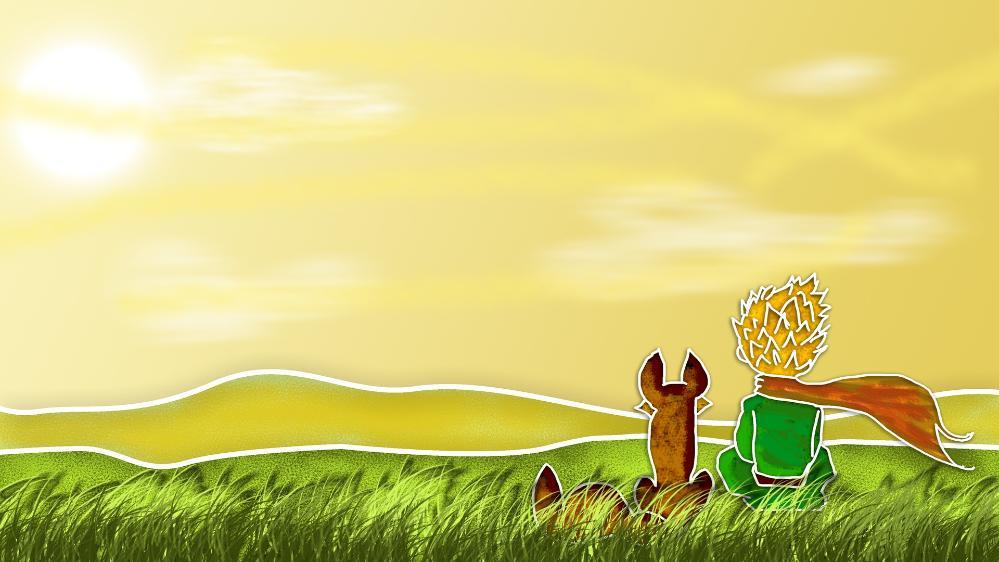“And now here is my secret, a very simple secret: It is only with the heart that one can see rightly; what is essential is invisible to the eye.”1
This quote from Antoine de Saint-Exupery’s internationally beloved novella, The Little Prince (originally written in French as Le Petit Prince), captures the essence of his allegorical story involving the encounter of a golden-haired boy in the Sahara Desert. The story is told through a sombre imaginary account, describing pieces of the narrator’s own childhood and his present troubles as a stranded aircraft pilot, as well as his conversations with a boy he meets whom he calls the “little prince” — through which he remembers the importance of childlike imagination, and perceiving what is true and essential. The story closes with the mysterious departure of the little prince and the narrator coming to terms with this loss.
"In interesting ways, The Little Prince also helps us expand upon not just the theological significance of allegory—but the childlike imagination as a virtue in knowing God."
The Little Prince delves into deceptively simple but profound themes. Through symbolism, it extols a childlike imagination, innocence, and wonder; reveals the follies of self-centred, egoistical, or close-minded thinking—something often associated by Saint-Exupéry with “grown-ups” (in contrast to children); and speaks of the nature of love and relationships. Running throughout the novella is the perspicuity of the childhood imagination to perceive “what is essential.” In interesting ways, The Little Prince also helps us expand upon not just the theological significance of allegory—but the childlike imagination as a virtue in knowing God.
The little prince himself is a complex character that represents both childlikeness and maturity, and is someone who is greatly concerned with what is truly important, despising grown-up “matters of consequence.” It is immediately evident that he has a rich imagination, correctly interpreting the narrator’s childhood drawing,2 a yardstick that the narrator uses to determine “a person of true understanding.” Saint-Exupéry contrasts this childlikeness with adult folly through the various characters he meets. The king desires the respect of his authority, and thus only gives self-fulfilling commands; the conceited man desires admiration, and perceives “all other men [as] admirers”; the tippler drinks to forget the shame of drinking; the businessman counts the stars and owns them so that he can buy more stars; the lamplighter faithfully follows unknown orders to light and put out his lamp unceasingly; and the geographer records the location of natural features on the planets, but has never left his desk. Saint-Exupéry relates these archetypes back to the condition of our society: “One can count, [on the Earth], 111 kings . . . 7000 geographers, 900,000 businessmen, 7,500,000 tipplers, 311,000,000 conceited men—that is to say, about 2,000,000,000 grown-ups.”3
The theme of the danger and futility of the ego runs through the little prince’s interactions with the adults, who yearn to be recognized, yet whose hubris prevents them from perceiving the empty cyclicality and pomp of their actions. The follies of “adult” ego wholly taking over the inner life echo the biblical reminder to us about the relative transience of this life. “What is your life? For you are a mist that appears for a little time and then vanishes”(James 4:14).
"Much like a child that receives the kingdom of God and knows its worth, only children, emptied of ego, know what is important to them, and can perceive true 'matters of consequence.'"
A common trait of the grown-ups is their insistence on “mastering” natural law (the businessman owning the stars or the king ruling over the planets) instead of coming under it in humility. This is further emphasized through the little prince’s encounter with the railway switchman—that adults “in bundles of a thousand” are “in a great hurry,” and that no one, not even the locomotive engineers, know what they are looking for.4 Subtly, a link is drawn between humble submission and alignment to a higher order to find one’s meaning, juxtaposed with frenetic energy and profound restlessness. Children are lucky, suggests Saint-Exupéry, because “only the children know what they are looking for.”5 Much like a child that receives the kingdom of God and knows its worth, only children,6 emptied of ego, know what is important to them, and can perceive true “matters of consequence.”
However, it is most likely today that many of us find ourselves identifying most closely with the position of the narrator, who appears to go through a kind of Sehnsucht7—a wistfulness and alienation as he looks back, with a sense of distance, on childlike imagination. The presence of the little prince invokes this for him, as he remarks: “[The little prince] thought, perhaps, that I was like himself. But I, alas . . . am a little like the grown-ups. I have had to grow old.”8
While the narrator is not explicitly identified as Saint-Exupéry, his own experiences certainly played a significant role in informing the story, with the narrator functioning as a stand-in for his own worldview whilst creating space for readers to identify with an everyman character. While delivering airmail in 1935, Saint-Exupéry’s own plane crashed in the middle of the Sahara, before his rescue by a Bedouin tribesman.9 He described his grave experience in aviation as “coming to grips with reality,” being plunged “directly into the heart of mystery”.10 When reminded of his childhood imaginative playtimes through the transformative nature of the desert, Saint-Exupéry writes of “the dark and golden park we peopled with gods; the limitless kingdom we made . . . . We created a secret civilization where footfalls had a meaning and things a savour known in no other world”.11 In addition, his setting aside of his childhood imagination due to being curtailed by adult criticism12 has given rise to interpretations that the character of the little prince is symbolic of his own inner child, with whom he metaphysically reckons with through the incident, and eventually forms a bond of understanding and continuity. In his book The Anguished and the Enchanted, Bowker fleshes out this interpretation of the narrator meeting his inner child:
“Most readers of Le Petit Prince remark immediately that the narrator is, in a profound yet unexplained way, connected to ‘the little prince’ . . . . We are told that the narrator was six years old when he first drew and then gave up drawing. . . . The prince—whose age is never specified but for whom six years seems about right—immediately demands that the narrator take up his childhood activity of drawing. Moreover, it takes six years for the narrator to begin to heal from his grief at the boy’s death (and/or his ascension). . . . In this time, it might seem that the boy is being figuratively re-born, year by year, coming to life again in the narrator’s imagination and arriving at that special age when the narrator’s creativity and hope both came alive and was shattered”.13
The most mysterious part of the story is the “death” of the little prince and what it signifies. The prince arranges for a poisonous snake to bite him, and in his final sad and Gethsemane-like exchange with the narrator, tells him that he is going home to the stars. Like the account of the empty tomb on the first Easter, the narrator “did not find his body at daybreak.”14 Yet, in a subtle but extraordinary way, the narrator now shifts to focus on childlike concerns as he concludes his account: “When I drew the muzzle for the [little prince’s sheep], I forgot to add the leather strap to it. . . . Now I keep wondering: What is happening on his planet? Perhaps the sheep has eaten the flower. . . .”15 His earlier token attempts to satisfy the little prince’s requests, and the “great mental effort”16 to think like the little prince in the past have been transformed—now he is genuinely concerned, and thinking from a childlike perspective. In other words, though there was grief, the narrator has gained the cherished childlike perspicuity that the little prince embodied. The little prince, though now “gone,” has been re-birthed and now lives on (so to speak) in the narrator through his re-enchantment.17 The narrator has met his lost inner child, and they have been reconciled.
This presents hope for all of us who find ourselves in the narrator’s position. It echoes the nature of the conversation that Jesus had with Nicodemus in John 3, who asks in confusion as he tries to square Jesus’s teaching about the new birth with practical logic: “How can these things be?” Indeed, how can one truly be born again of the Spirit, and be changed so deeply within? As believers, it is an invitation for us to consider the role of childlike imagination in perceiving God no matter what our age may be, and to rethink our perceptions in which opposing traits can be deeply embedded. If we are able to dethrone our desire to exert mastery and humbly receive mystery, we can, similar to the narrator, be affected by real spiritual and inner transformation, and receive the kingdom in childlike faith.

